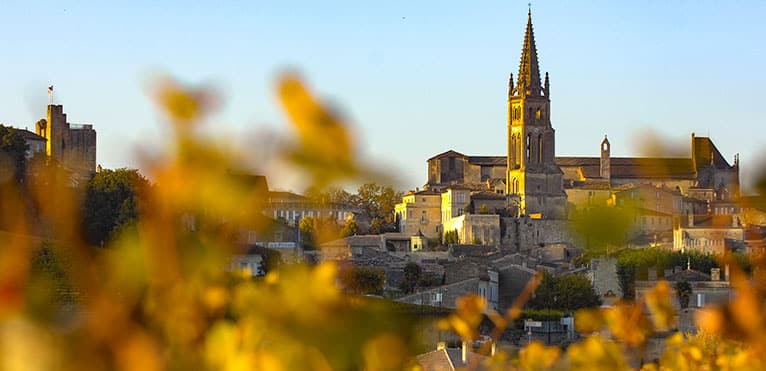
Contents
Saint-Estèphe is the most northerly communal appellation in the Médoc wine region of Bordeaux. It lies to the north of the Pauillac appellation, from which it is separated by a simple stream.
Recognized since 1936 as a Protected Designation of Origin, this geographical area produces wines of character, quite robust and incisive. However, they may have different profiles, which is linked to the diversity of soils and exposure of the vines within the appellation.
Saint-Estèphe, a vineyard enhanced by the 1855 classification
The history of Saint-Estèphe wines dates back to the Romans, who began cultivating vines here over 2,000 years ago. The Bordeaux wine trade didn’t really take off until the Middle Ages, following the marriage of Eleanor of Aquitaine to the King of England. In the 1500s, Henri IV had the land drained to improve the Médoc’s viticulture. These innovations, together with the careful drying out of the vineyards, enabled them to become much more fertile.
This is why, a few centuries later, and more precisely in the 19th century, great vineyards were recognized for their incredible quality. The Napoleon classification, carried out prior to the 1885 Paris Universal Exhibition, ranked 5 crus classés; two 2th Grands Crus Classés, Château Cos d’Estournel and Château Montrose, a 3th Grand Cru Classé, Château Calon-Ségur, a 4th Grand Cru Classé Château Lafon-Rochet and finally a 5th Grand Cru classé Château Cos Labory. The appellation also stands out for its 22 Crus Bourgeois and its Cru Artisan.
The Saint-Estèphe vineyards are located in various communes
Saint-Estèphe is a Médoc appellation located north of Pauillac, and comprises 5 hamlets (Marbuzet, Blanquet, Pez, Leyssac and Saint-Corbian) and its eponymous commune.
The vineyards are planted in a variety of landscapes, and therefore on soils with different characteristics. It is partly made up of gravelly terraces and hilltops at altitudes ranging from 4 to 40 metres. To the west, the soils are predominantly limestone, sand and gravel, protected from the wind by the Landes forest. To the east, close to the Gironde estuary, we find limestone alluvium and oyster marl from the “Saint-Estèphe” area.
Despite differences in temperature and exposure to winds, the climate throughout the vineyards can be considered temperate oceanic. The variety of soils and the different exposure of the vines to climatic conditions nevertheless give the appellation’s wines a unique character, depending on their area of production.
Saint-Estèphe are typical Médoc wines
Like almost all Bordeaux wines, Saint-Estèphe ‘s are characterized by a deep ruby hue with reflections tending towards black. And while their color may change as they age, it always remains deep red. These wines offer plenty of fruit on the nose, including notes of ripe fruit such as blackcurrant. There are also more floral aromas, particularly that of violets, as well as ageing aromas (spices, licorice, roasting). It’s fair to say that the nose of Saint-Estèphe wines is typical of the Médoc, i.e. quite lively and incisive.
On the palate, these are powerful wines with a fine, deep tannic structure. The tannins mellow and offer perfect harmony, and after several years of cellaring the bouquet becomes more complex. Wines produced on Saint-Estèphe soils can be kept for an average of 10 to 20 years, which represents excellent ageing potential. The best vintages can be kept for up to 20 years.
Thanks to their fine structure, Saint-Estèphe wines bring real balance to the menu when paired with red meat, leg of lamb or poultry in sauce. And since it’s interesting to serve food and wine from the same terroir, it makes sense to pair a suckling lamb from Pauillac with a Saint-Estèphe, for example.
For the best vintages of Saint-Estèphe, consider 2000, 2005, or 2009.
The best vintages are those years in which wine production is of a higher quality than in traditional years. The Saint-Estèphe appellation, for example, has several millennium vintages, including 1945 and 2005. 1992 and 1990 are considered vintages of the century, while 2000 and 2009 are considered exceptional vintages.
Exceptional châteaux in Saint-Estèphe
Château Calon Ségur
Located in the commune of Saint-Estèphe, the château owes its name to the commune’s former name and to the patronymic of the Marquis de Ségur. The commune of Saint-Estèphe was named Saint-Estèphe en Calon, after the boats used to transport wood from one bank of the Gironde to the other. Subsequently, several families successively owned the property, which is now owned by Suravenir Assurance.
Château Montrose
Château Montrose owes its history to three successive families. They had different but complementary methods, and turned it into a prestigious Saint Estephe estate. First of all, Théodore Dumoulin gave birth to this vineyard, and built the structures necessary for its operation as early as 1815. Then, in 1866, Mathieu Dolfus reorganized the château and modernized the winemaking process. He was a model, forward-thinking boss who used modern managerial techniques and offered exceptional benefits to his staff.
Finally, until 2006, Jean-Louis Charmolue continued the quest for excellence begun by his predecessors. Today, the Bouygues brothers are at the helm of the estate, and have chosen to take it in a significant environmental direction.